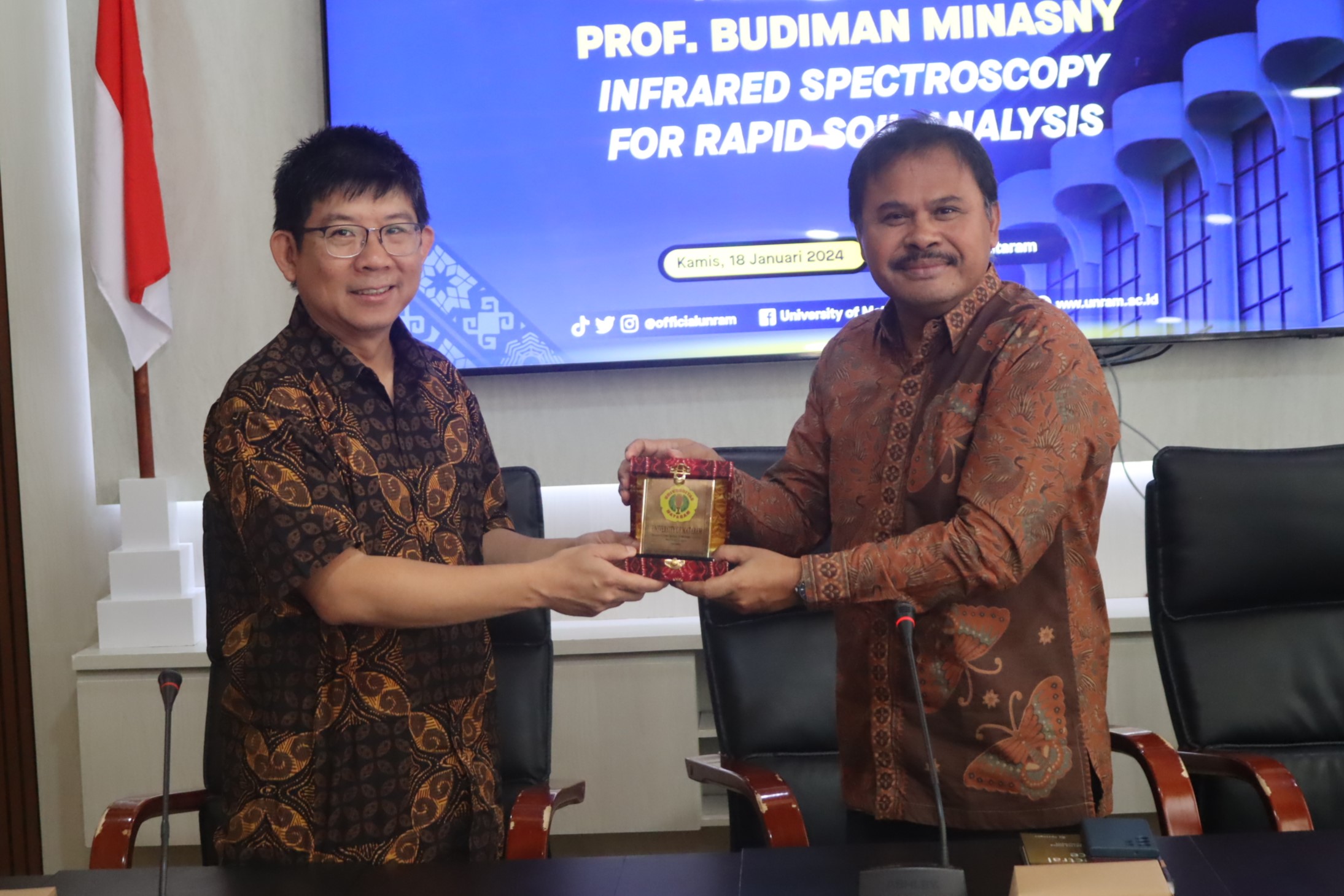Unram Holds Public Lecture on Digital Soil Spectroscopy

Mataram, University of Mataram – University of Mataram (Unram) held a public lecture presenting Prof. Budiman Minasny as a guest speaker. This public lecture entitled Infrared Spectroscopy for Rapid Soil Analysis, took place in the Rector’s Conference Room, Unram Rectorate on Thursday (18/1).
Prof. Budiman is a professor of soil landscape modeling at the University of Sydney. Soil, Carbon and Water theme leader at the Sydney Institute of Agriculture, received QEII and Future Fellowships from the Australian Research Council and was recognized as the most cited researcher in 2019 by Web of Science.
The Rector of Unram, Prof. Ir. Bambang Hari Kusumo, M.Agr.St., Ph.D in his speech expressed his high appreciation to Prof. Budiman Minasny, and hopes that this public lecture will be the beginning of a strong collaboration with Prof. Budiman.
Prof. Bambang also shared about his long-standing friendship with Prof. Budiman.
“We met in 2008 at the University of Sydney, in the first conference related to Proximal Soil Intelligence, where I had the opportunity to present the results of research that I started in 2005 when I started my PhD at Massey University, New Zealand. I met Prof. Budiman there and we became close. When I visited the University of Sydney at the end of last year, Prof. Budiman welcomed me and came to our place,” said Prof. Bambang.
Furthermore, Prof. Bambang said there was one idea that was shared with Prof. Budiman, about how farmers can find out what type of fertilizer is applied, the management that wants to be done is simply by entering the coordinates of the land into the website, then data will appear about the condition of the land, including fertilization recommendations and so on. This is a great idea that has passed the central funding but was stopped due to Prof. Bambang’s work as the Rector of Unram.
“Unram will purchase the latest version of a tool called Near Infrared Spectroscopy and this is what I discussed with Prof. Budiman. Where we will try this big idea in one sub-district, namely Kayangan sub-district, where we will plot the island of Lombok first. It is so accurate that farmers who enter their land coordinates get complete information, including when entering different coordinates will continue to get different information depending on the real condition of the land. Different landscapes will have different characteristics and different management,” said Prof. Bambang.
Analyzing samples in the laboratory in large quantities takes quite a long time. But by using light reflections that are analyzed from soil diffuse reflection. When studying the interaction between material and light, when light strikes or hits the material, there is a frequency or response from the material experiencing vibrations. This unique vibration produces a frequency, it is this frequency that is captured by the sensor. Then the resulting wavelength is obtained information about the biological characteristics, physical characteristics of the soil that can be quantified, so it can measure nitrogen, organic matter, and other things in seconds making this method very efficient in terms of time.
Prof. Budiman in the public lecture said that soil not only plays an important role in agriculture, but has many other functions such as biomass, carbon, biodiversity, water, contaminants, and history. Soil spectroscopy offers fast and highly accurate measurements of various soil physical, biological and chemical properties. The use of spectrometers in the field and in combination with digital soil mapping can be an excellent soil monitoring tool.
Prof. Budiman further explained that VIS-NIR-MIR for soil analysis has the advantages of time and cost efficiency, requires minimum preparation, no need to use chemical reagents, and multiple properties can be predicted with a single scan.
The use of Near Infrared (NIR Spectrometry) for routine analysis, for example, can be used to analyze protein content in grains, water content in dry foods. In addition, it can also be used to analyze sugar in fruits so that it is commonly used to determine the level of maturity of grapes so that it helps in determining the day of harvest and the best process to be carried out in its processing.
Prof. Budiman in the public lecture also introduced the Paddy Watch Project program: Mapping and Monitoring Global Methane Emissions of Paddy Fields, which is automatic mapping and monitoring in near real time of the area, planting patterns, and growth stages of rice in Southeast Asia using the sentinel-1 time series on the Google Earth platform.
The Rector of Unram at the end of his remarks hoped that through this public lecture Prof. Budiman could also provide training related to the application of Near Infrared Spectroscopy technology in the future and all parties could receive the benefits of what was delivered by Prof. Budiman
